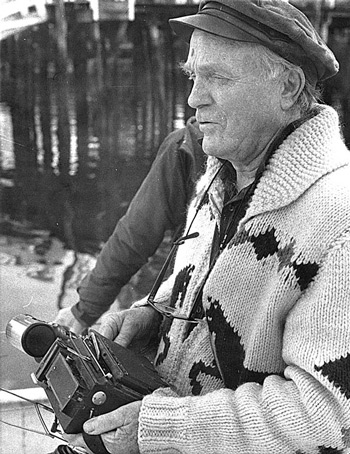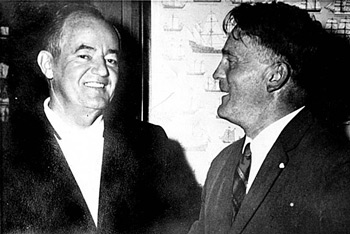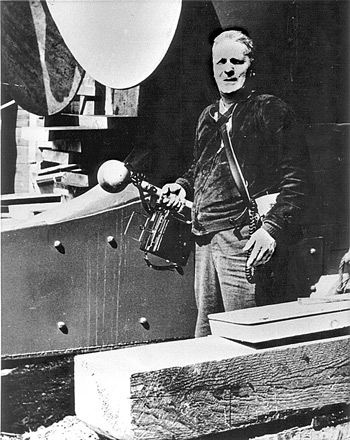One of a Kind
by Mike Crowe

In a pensive mood on the waterfront, Boutilier is studying the angle from which to make his next shipyard shot with his ever present Graphics 4x5 news camera. Red photographed the Maine waterfront and was the first to make boat launches a news event. Photo courtesy Everett Boutilier.
This story originally appeared in the September, 2002 issue of the Fishermen’s Voice.
Many people can say, that of the people they know, one of them is unlike themselves and the others – unusual in some way. Maybe it’s that person’s enthusiasm, unflappable calm, achievement, determination regardless of past outcomes, good fortune, or just a particular interest in something peculiar. The measure is not necessarily and needn’t be material. Along the coast of Maine more than a few people would say that Everett “Red” Boutilier is one of those unusual people.
Red Boutilier is unusual for what he has done, what he still does, and the fact that he has done it as long as he has. He is well known to coastal readers and publishers for the many articles he has written about people, boats and coastal life. His articles have appeared in a wide range of local and national newspapers and magazines. Working from his home, office and darkroom in Bremen, Maine, he has had his work published for as long as anyone can remember. At 85, there are not many people around who remember when Red was not.
Over the years he has worked as a crewman on three-masted schooners, a school teacher, Boy Scout executive, welder, athletic coach, newspaper reporter, horse racetrack publicist, freelance writer, photographer, farmer, and informal photo archivist. He also has a great mental archive of the events, people and life of the coast. Listening to Red’s recall of events, names and places of times past can be almost scary for someone who, at the same time, is fumbling through his pockets trying to remember where he left the car keys.
His father Earnest, was born in Chester, Nova Scotia where his roots run back to 1750 when five ships arrived, each with some of Red’s ancestors aboard. They had come as indentured servants expecting to farm the 60 acres they were promised as part of their immigration deal. As indentured servants they worked until they paid for their passage.
Earnest, a three-masted schooner captain and Grand Banker, moved the family to Fitchburg, Massachusetts, in 1917. Red believes his father got through immigration because Gloucester was short of fishermen at the time. His wife however, a teacher, feared he would be lost at sea and so they went inland to Fitchburg in search of work. It’s a place where mills were built on the river for the power in it, and around them a town developed. Red’s father went to work ironing shirts. He later was a supervisor at the Whitney Carriage Co. building horse-drawn carriages. An avid outdoorsman, he got involved in the development of the Boy Scouts of America, eventually becoming an executive there.

Despite keeping in touch with the boatyards and boat-builders in Northeastern Maine, Boutilier had time to dabble in politics. Everett “Red” Boutilier (right) with Senator Hubert Humphrey in 1962. Photo courtesy Everett Boutilier.
Red was born in 1917, in nearby Leominster, Mass. His was in a seafaring family, four of his uncles were schooner captains. As a boy in the 1930s he crewed with his cousins aboard three-masted schooners shipping salt barrels and mackerel along the Nova Scotia coast in the summer. The family traveled to Nova Scotia in a Model T Ford, a trip which took five days. In addition to an early interest in playing sports he was active in the Boy Scouts and in 1933 went with them to Hungary for an International Jamboree.
After graduating from Dart-mouth College in 1938, he started teaching. In 1942 he changed hats when he became a Field Boy Scout Executive in Waterville, Maine. At the same time he coached a basketball team at a local school. In 1943, with a wife and two children and World War II going strong, he got a job at the Bath Iron Works. The shipyard made him a production expediter. When he heard welders made $20 more a week, he traded his white collar job to be a welder.
While looking over a shipbuilding contract with the government, he noticed among the fine print that the shipyard was entitled to funding for a recreation program. He wrote and presented a proposal that led to the establishment of basketball, baseball, boxing, golf and wrestling programs at the yard. This later evolved into his next job as director of Athletics and Recreation at the Bath Iron Works.
In 1945, after the war, he wrote to the Frank Gannett newspapers for a job. He got one in Saratoga, N.Y. at the Saratogian, where he was sports editor and crime reporter. Saratoga, Red said, “was an active town, plus it had a professional basketball team and a horse track.” This was the newsroom era of switchboard operators, telephone numbers vocally requested, typewriters the size of small car engines, almost mandatory cigar and cigarette smoking on the job, and a pre-politically correct culture of the newspaperman. The action in Saratoga then, as now, was at the horse racing track. The track was what Red liked to cover; there were inherent possibilities in the action. He taught himself photography using an old Brownie camera and picking the brains of news photographers. Two years later he was transferred by Gannett to Utica where he was a general reporter and columnist, but there was less happening. He began writing farming articles and selling them to agricultural trade publications. A change in management, a sleepy news room and office politics at the paper were enough for Red to decide to pay off the mortgage on his house and quit his job in 1953.
He bought a 4x5 camera and went one morning to a new harness racing track to shoot some races and look for a job. There were 20 other photographers there looking for the same job. They all had photo studios. Red saw some drivers trotting horses and shot some pictures. He knew the owner needed pictures by 4:30 p.m. for the racing magazine. Red drove eight miles back to town to his simple basement darkroom. When he returned with the photographs the track owner was a bit amazed and gave him a publicity job at the Vernon Downs track. Fast turnaround became an edge for Red’s reporting. In the off season he traveled to tracks in Florida, North Carolina and Kentucky, taking the 20-foot trailer with a dark room and living quarters he built in 1956. It had bunks that folded down; in this case, over the photo trays. He sold photographs to publications, horse owners, jockeys, the tracks and fans. His wife and daughter regularly worked printing and later taking photographs with Red.
It was 1958 when Red went to the Hinsdale, N.H. track where he was assistant race secretary. At Hinsdale photography played a larger role in what he did and changed the way he made a living. His daughter began running the photography concession at the track.
The mobile dark room enabled him to go to many tracks large and small including the Blue Hill, Cumberland, Windsor and Fryeburg fairs. When New York state decided to require track employees to have photos on their licenses, the Boutiliers got the job. Red, his wife and daughter had to produce 1,200 photos in a week. They didn’t have a dryer so they ironed them. His daughter then ran the photo sales concession from the trailer.
He went on to do publicity at Foxboro, Mass., Gorham and Lewiston, Maine, tracks before beginning a 40-year career as a freelance writer and photographer in 1962. Having worn many hats in his life, often more than one at the same time, has given him a particular flexibility and perspective.
He bought his current home in 1959, a big old farmhouse, in Bremen. It was here, in the off season, that he got interested in photographing boats. His “off road, I’ll be doing it my way, thanks” style has been reflected in his writing over the years and in his approach to life. He continued to work at what he had been doing, but now did some farming, eventually building a herd of 25 milk cows. He and his son raised cattle for twenty years.
Three rooms on the second floor of his rambling early 19th century house are Red’s darkroom and photo storage. Decades of photos are stored in marked boxes. Decades of photos means floor to ceiling on four walls. There are as many more boxes in the attic. He said he has 5,000 horse photos alone.

Red Boutilier. Shooting at what is likely the Harvey Gamage yard in South Bristol, Maine, given the size of the propeller in the background and what looks like a metal hull. Photo courtesy Everett Boutilier.
There were no race horses to photograph in Bremen, but there were boats being launched. When Red approached builders to ask to photograph their recently completed boat they asked, “Why the hell do you want to do that?” But Red took more than a snapshot and wrote about more than the length, beam and engine displacement. He recognized that there was more going on in the building and launching of a boat, and wrote about those things. Information packed into the short articles ran from the wood lot the wood was cut off, to the builder’s youngest son just entering the business. He covered the style of boat, the materials, problems solved, who the owner was, why they had it built and special features. The builder, his background, his family, past boats and building techniques were also woven into the launching story and photograph. He was also known for his unique camera angles. After traveling to the launch of a large yacht, weather kept it in a shed. Rather than leave without a photograph, he climbed into a metal barrel and had the company crane lift him high over the deck for a bird’s eye view.
Red has known some of the major boat builders in Maine. He said Harvey Gamage was timid about having photos taken and a story done. But after he saw his eight-page story published in Sailing magazine, he was very interested and soon willingly posed for the camera.
Recalling one of the first stories he sent out to a publication while at the Saratogian back in the ’40s, he said, “the same story the paper paid $1.25 for, I was paid $125 by a farming magazine.”
Over the years he has sold articles and photographs to a wide range of publications, too long to list here, on a wide range of subjects. But they include Downeast, National Fisherman, Commercial Fisheries News, Sail, Sailing, Yacht- ing, Fishing Gazette, Soundings, Classic Boat Monthly, Offshore and Maine Life, and of course The Fishermen’s Voice
For ten years he did picture pages for the King Features Syndi- cate. Subjects include the sports and boats already mentioned, whale processing in Canada, the big boat sheds at Washburn and Doughty, car races on frozen lakes, schooner building and races, light houses, sailing ships, county fairs, the Appalachian Trail and logging.
Ten years ago Red heard about a guy who was approaching the end of a run on the Appalachian Trail from Georgia to Mt. Katahdin. Red began tracking the runner’s approach by reading about sightings in newspapers and on radio broadcasts. He heard the runner was nearing the trail’s end at Mt.Katahdin. Estimating the runner’s speed and remaining distance, Red packed his camera equipment and drove to Baxter State Park. Loaded down with 25 pounds of camera gear, he climbed Mt. Katahdin. David Horton, the 41-year-old professor of physical education from Lynchburg, Va. had run the trail in 52 days, 9 hours and 41 minutes. When the runner reached the exhausting end of his 2,000 mile journey, climbed the steep trail to the trail’s end at the mile high peak, his eyes came up over the flat top of Katahdin he had envisioned for so long, and all he saw was a 75-year-old man looking at him through a camera lens. Red who had arrived 20 minutes before him, was the only photographer there, along with a Suffix, N.B. veterinarian was also, by coincidence, at the top.
Red continues to write. He regularly writes for Working Waterfront and is a contributing editor at Maine Boats and Harbors.
Many of Red’s readers are hoping to hear of his experiences on the last log drive at Machias which was some time in the 1960s.
Everett “Red” Boutilier is one of a kind – an original who has been interested in his work and done it well for almost two working lifetimes. For those turning 30 and worried about it, or those thinking 50 is just about the end of it all – Red was called one afternoon recently about using some of his photographs for this story. He said “sure” in his gravelly, no-nonsense, 1940s newsroom way. Although it would depend some on whether he had prints, but he would look through what he had. That call was made around 2 p.m. Around 6 p.m. the same day, another call to Red was made about something else regarding this story. He said he had gotten the photographs in the mail at 4 p.m. Red “Mr. Hustle” Boutilier.
Red Boutilier passed away in February, 2003. His vast collection of photographs was acquired by the Penobscot Marine Museum in Searsport, Maine. The museum is working to preserve Red’s work and story.
